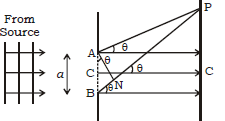(a) Using Huygens’s construction of secondary wavelets explain how a diffraction pattern is obtained on a screen due to a narrow slit on which a monochromatic beam of light is incident normally.
(b) Show that the angular width of the first diffraction fringe is half that of the central fringe.
(c) Explain why the maxima at  become weaker and weaker with increasing n.
become weaker and weaker with increasing n.
a) Diffraction of light at a Single slit
A single narrow slit is illuminated by a monochromatic source of light. The diffraction pattern is obtained on the screen placed in front of the slits. There is a central bright region called as central maximum. All the waves reaching this region are in phase hence the intensity is maximum. On both sides of the central maximum, there are alternate dark and bright regions, the intensity becoming weaker away from the center. The intensity at any point P on the screen depends on the path difference between the waves arising from different parts of the wave front at the slit.
According to the figure, the path difference (BP – AP) between the two edges of the slit can be calculated.
Path difference, BP – AP = NQ = 
Angle  is zero at the central point C on the screen, therefore all path difference is zero and hence all the parts of the slit are in phase.
is zero at the central point C on the screen, therefore all path difference is zero and hence all the parts of the slit are in phase.
Due to this, the intensity at C is maximum. If this path difference is, (the wavelength of light used), then P will be the point of minimum intensity.
This is because the whole wave-front can be considered to be divided into two equal halves CA and CB and if the path difference between the secondary waves from A and B is  , then the path difference between the secondary waves from A and C reaching P will be
, then the path difference between the secondary waves from A and C reaching P will be  /2, and path difference between the secondary waves from B and C reaching P will again be
/2, and path difference between the secondary waves from B and C reaching P will again be  /2. Also, for every point in the upper half AC, there is a corresponding point in the lower half CB for which the path difference between the secondary waves, reaching P is
/2. Also, for every point in the upper half AC, there is a corresponding point in the lower half CB for which the path difference between the secondary waves, reaching P is  /2. Thus, destructive interference takes place at P, and therefore, P is a point of first secondary minimum.
/2. Thus, destructive interference takes place at P, and therefore, P is a point of first secondary minimum.
b)
Central bright lies between, 
Therefore, Angular width of central bright fringe = 
So, 1st diffraction fringe lies between 
Therefore,
Angular width of first diffraction fringe is, 
Hence proved.
c) As n increases, part of the slit contributing towards maximum decreases. Therefore, maxima gets weaker with increasing n.
